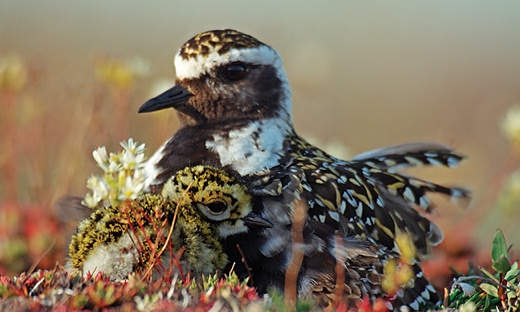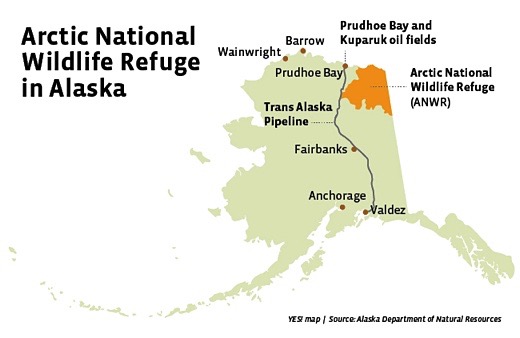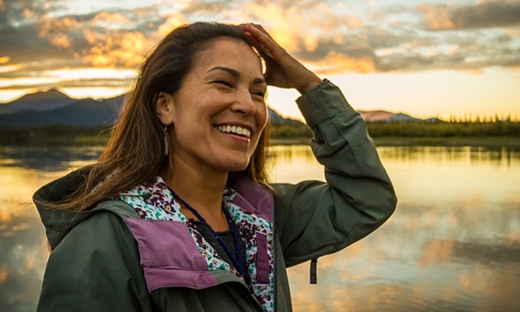SUBHEAD: In Alaska indigenous voices are raised to permanently protect the Arctic National Wildlife Refuge.
By Stephan Miller on 10 October 2016 for Yes Magazine -
(http://www.yesmagazine.org/people-power/the-oil-fight-in-the-arctic-alaska-tribe-wants-16-billion-barrels-to-stay-in-the-ground-20161010)

Image above: Caribou forage in the Arctic National Wildlife Refuge. Photo by Florian Schulz. From original article.
As a child, Princess Lucaj was mystified by the oil wells she saw while visiting Los Angeles and the La Brea Tar Pits. She imagined they were dinosaurs and wondered what they could be up to.
Her mother explained: A long time ago, Mother Earth buried toxins deep in the ground to keep them from harming people. But now people are digging them up.
Since then, Lucaj, a member of the Gwich’in tribe of northern Alaska, said she has been plagued by the realization that “we are not living in harmony with the Earth.”
For years, Congress has been pressed to permanently protect the Arctic National Wildlife Refuge. Will today’s indigenous-led climate movements finally seal the deal?
The oil and gas industry accounts for more than three-quarters of the Alaskan government's discretionary revenue, and the state has seen a near constant tug of war over land rights for extraction.
An area of particular interest is the coastal plain of the federally designated Arctic National Wildlife Refuge (ANWR) on the continent’s northern coast. The U.S. Geological Survey estimates this area may hold as much as 16 billion barrels of recoverable crude oil and natural gas.
It also holds enormous significance for the Gwich’in people. The coastal plain is essential birthing ground for the Porcupine caribou herd, on which the Gwich’in have traditionally depended for subsistence.

Image above: An American Golden-Plover and its chick bed down in the Arctic Refuge. Photo by Florian Schulz. From original article.
“We have a spiritual relationship with the herd that dates back thousands of years,” Lucaj said. “We take care of the herd, and the herd takes care of us.” Taking care of the herd means protecting critical ecosystems like the coastal plain, which provides the caribou with a safe haven to rear their young at the end of their 1,500-mile land migration—the longest of any land mammal.
Recognizing the ecological and cultural importance of this area, the federal government established the ANWR—19 million acres in total—in 1960 and expanded it in 1980, designating 8 million acres as protected wilderness, but deferring permanent protection of 1.5 million crucial acres of the coastal plain to future congressional approval. Since then, native groups, government, industry, and environmentalists have argued for their interests.
Writer, filmmaker, and former executive director of the Gwich’in Steering Committee, Lucaj is one of many who has worked to ensure the long-term health of the Porcupine herd—and ultimately the people who depend on it.
A cursory look at ANWR’s history shows how the refuge has been used as a political game piece: championed as an asset for economic and national security by Republican members of Congress and presidents who wished to see it open for drilling (“Drill baby, drill!”), and shakily protected by Democrats and moderate Republicans pressured by some tribes and environmentalists.
In January 2015, President Obama formally recommended that Congress permanently ban drilling across about 12 million acres of ANWR, including the coastal plain. His request was met with harsh criticism from conservative legislators, the most vocal of which has been Alaska Republican Sen. Lisa Murkowski, who is up for re-election this November.

Image above: Map of Alaska with Arctic refuge in orange east of the Trans Alaska Pipeline. From original article.
With the economic hard times Alaska is experiencing today, there is increased pressure to open the refuge for drilling. “We are in such a fiscal crisis, and legislators are grasping at straws because oil has always been the answer for everything,” Lucaj said. “It’s all we know how to do up here—or so they tell us.”
Many Alaskans have reputations for pride and stewardship of their land, and more recently those people with the longest connection to that land are being heard.
“Threats have always been lingering but we have a lot more momentum and public support across the nation, but also in Alaska,” Lucaj explained. She said the Sioux-led resistance to the Dakota Access pipeline has been a catalyst for movements across the country, elevating Indigenous voices that are calling for the protection and recognition of the importance of land.
Lucaj wrote the following essay for “We are the Arctic,” an anthology of voices connected to the ANWR region, published this year by Mountaineers Books.
The caribou calf slips out of the womb and onto the soft padding of the tundra. Steam rises off its body, new to the world, to air, to life on Earth. In these first few hours he will bond with his mother, learning how to suckle, how to identify her scent and voice. These hours are critical to the survival of mother and calf in a herd of thousands. It is the only time they will have alone together.
We humans are not so different in the way we give birth. The basics needed for life to begin. A mother’s warm body full of milk and reassurance. A safe place. A warm cabin. A manger. A refuge.
All of us who over-consume must pay a price in the grand scheme of life. The coastal plain of the Arctic National Wildlife Refuge is sacred ground, deemed so by the births of millions of animals over thousands of years. And my people, Gwich’in, are there today only because of the spiritual bond we have with the Porcupine caribou herd.
In our culture the caribou give themselves to us so that we may survive. We are humbled. Each of us humans should walk with that humbleness, knowing that it is ultimately this massive cycle of life that provides us with what we need to survive: clean air and water, soil to grow our gardens, and the fish and wildlife on which many of us depend.
All life is sacred. We all want to live, to experience the gift of creation—this great mystery we are all a part of.

Image above: Princess Lucaj is a Gwich’in Athabascan writer, filmmaker, and advocate for the protection of the Porcupine caribou herd. Photo by Ryan Red Corn. From original article.
Truly we are related. You and I are brother and sister. We are related to the caribou, and whales, and polar bears; we are even related to the birch trees, and the forget-me-nots, and the tundra grass.
Shalak naii, my relatives—let us carry this knowledge in our hearts and minds as we continue on our respective journeys. And hai’choo to you who are working so tirelessly for our future generations!
.
By Stephan Miller on 10 October 2016 for Yes Magazine -
(http://www.yesmagazine.org/people-power/the-oil-fight-in-the-arctic-alaska-tribe-wants-16-billion-barrels-to-stay-in-the-ground-20161010)

Image above: Caribou forage in the Arctic National Wildlife Refuge. Photo by Florian Schulz. From original article.
As a child, Princess Lucaj was mystified by the oil wells she saw while visiting Los Angeles and the La Brea Tar Pits. She imagined they were dinosaurs and wondered what they could be up to.
Her mother explained: A long time ago, Mother Earth buried toxins deep in the ground to keep them from harming people. But now people are digging them up.
Since then, Lucaj, a member of the Gwich’in tribe of northern Alaska, said she has been plagued by the realization that “we are not living in harmony with the Earth.”
For years, Congress has been pressed to permanently protect the Arctic National Wildlife Refuge. Will today’s indigenous-led climate movements finally seal the deal?
The oil and gas industry accounts for more than three-quarters of the Alaskan government's discretionary revenue, and the state has seen a near constant tug of war over land rights for extraction.
An area of particular interest is the coastal plain of the federally designated Arctic National Wildlife Refuge (ANWR) on the continent’s northern coast. The U.S. Geological Survey estimates this area may hold as much as 16 billion barrels of recoverable crude oil and natural gas.
It also holds enormous significance for the Gwich’in people. The coastal plain is essential birthing ground for the Porcupine caribou herd, on which the Gwich’in have traditionally depended for subsistence.

Image above: An American Golden-Plover and its chick bed down in the Arctic Refuge. Photo by Florian Schulz. From original article.
“We have a spiritual relationship with the herd that dates back thousands of years,” Lucaj said. “We take care of the herd, and the herd takes care of us.” Taking care of the herd means protecting critical ecosystems like the coastal plain, which provides the caribou with a safe haven to rear their young at the end of their 1,500-mile land migration—the longest of any land mammal.
Recognizing the ecological and cultural importance of this area, the federal government established the ANWR—19 million acres in total—in 1960 and expanded it in 1980, designating 8 million acres as protected wilderness, but deferring permanent protection of 1.5 million crucial acres of the coastal plain to future congressional approval. Since then, native groups, government, industry, and environmentalists have argued for their interests.
Writer, filmmaker, and former executive director of the Gwich’in Steering Committee, Lucaj is one of many who has worked to ensure the long-term health of the Porcupine herd—and ultimately the people who depend on it.
A cursory look at ANWR’s history shows how the refuge has been used as a political game piece: championed as an asset for economic and national security by Republican members of Congress and presidents who wished to see it open for drilling (“Drill baby, drill!”), and shakily protected by Democrats and moderate Republicans pressured by some tribes and environmentalists.
In January 2015, President Obama formally recommended that Congress permanently ban drilling across about 12 million acres of ANWR, including the coastal plain. His request was met with harsh criticism from conservative legislators, the most vocal of which has been Alaska Republican Sen. Lisa Murkowski, who is up for re-election this November.

Image above: Map of Alaska with Arctic refuge in orange east of the Trans Alaska Pipeline. From original article.
With the economic hard times Alaska is experiencing today, there is increased pressure to open the refuge for drilling. “We are in such a fiscal crisis, and legislators are grasping at straws because oil has always been the answer for everything,” Lucaj said. “It’s all we know how to do up here—or so they tell us.”
Many Alaskans have reputations for pride and stewardship of their land, and more recently those people with the longest connection to that land are being heard.
“Threats have always been lingering but we have a lot more momentum and public support across the nation, but also in Alaska,” Lucaj explained. She said the Sioux-led resistance to the Dakota Access pipeline has been a catalyst for movements across the country, elevating Indigenous voices that are calling for the protection and recognition of the importance of land.
Lucaj wrote the following essay for “We are the Arctic,” an anthology of voices connected to the ANWR region, published this year by Mountaineers Books.
The caribou calf slips out of the womb and onto the soft padding of the tundra. Steam rises off its body, new to the world, to air, to life on Earth. In these first few hours he will bond with his mother, learning how to suckle, how to identify her scent and voice. These hours are critical to the survival of mother and calf in a herd of thousands. It is the only time they will have alone together.
We humans are not so different in the way we give birth. The basics needed for life to begin. A mother’s warm body full of milk and reassurance. A safe place. A warm cabin. A manger. A refuge.
All of us who over-consume must pay a price in the grand scheme of life. The coastal plain of the Arctic National Wildlife Refuge is sacred ground, deemed so by the births of millions of animals over thousands of years. And my people, Gwich’in, are there today only because of the spiritual bond we have with the Porcupine caribou herd.
In our culture the caribou give themselves to us so that we may survive. We are humbled. Each of us humans should walk with that humbleness, knowing that it is ultimately this massive cycle of life that provides us with what we need to survive: clean air and water, soil to grow our gardens, and the fish and wildlife on which many of us depend.
All life is sacred. We all want to live, to experience the gift of creation—this great mystery we are all a part of.

Image above: Princess Lucaj is a Gwich’in Athabascan writer, filmmaker, and advocate for the protection of the Porcupine caribou herd. Photo by Ryan Red Corn. From original article.
Truly we are related. You and I are brother and sister. We are related to the caribou, and whales, and polar bears; we are even related to the birch trees, and the forget-me-nots, and the tundra grass.
Shalak naii, my relatives—let us carry this knowledge in our hearts and minds as we continue on our respective journeys. And hai’choo to you who are working so tirelessly for our future generations!
.
No comments :
Post a Comment